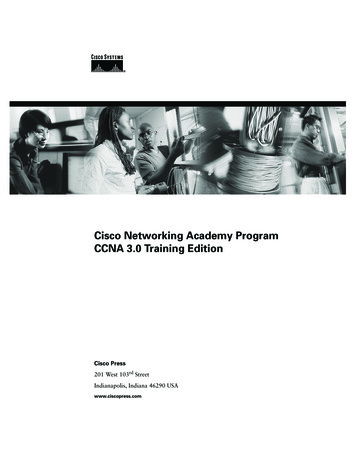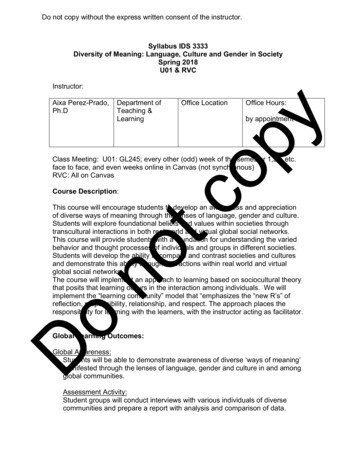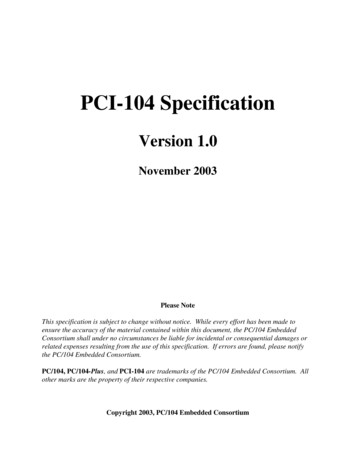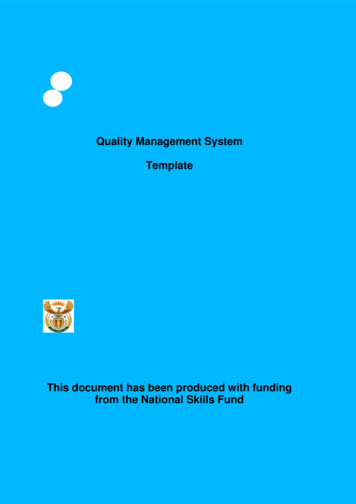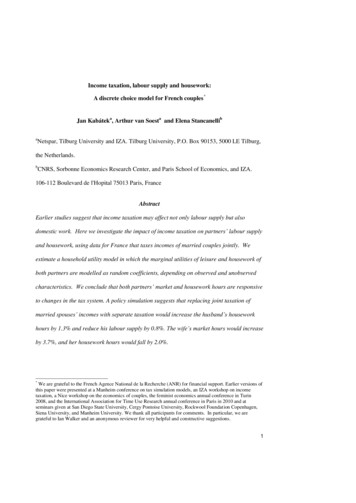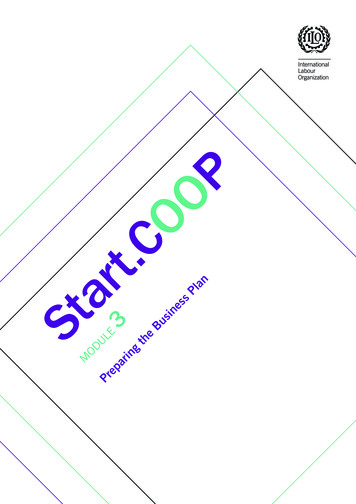
Transcription
grinPrepaethULEODMssnesiBuanPlSta3 rt.COOP
Start.COOPMODULE3Preparing the Business PlanI
Start.COOP by International Labour Organization (ILO) is licensed under a Creative CommonsAttribution-NonCommercial-ShareAlike 4.0 Unported License.Start.COOPStart.COOP has been developed as a low-cost, easy to use training tool for those interested instarting and launching a cooperative in a participatory and efficient manner. It draws on technicalcontent from existing materials in different ILO cooperative training tools and peer-to-peer, activitybased learning methodology from the ILO’s Community-Based Enterprise Development (C-BED) programme. The Start.COOP training tool has been divided into four modules that correspond to eachphase of the cooperative formation process to give you time to reflect on the importance of whatyou are doing at a given time and to see how it fits into the big picture. The focus of the Start.COOPmodules is on the decisions to be made at each step with a view to increasing chances of success.At the end of the training you will be able to: Identify the core members of your cooperative Define your business idea Research the feasibility of your business idea Prepare your business plan Decide on the organizational set-up of your cooperativeTo learn more about the ILO’s work on cooperatives visit www.ilo.org/coop or email:coop@ilo.orgTo learn more about the ILO’s peer-to-peer, activity based learning methodology visitwww.cb-tools.orgAcknowledgementsStart.COOP was developed collaboratively by the ILO Decent Work Team Bangkok and the Cooperatives Unit of the Enterprises Department at the ILO. The text was drafted by Marian E. Boquiren.Start.CoopILO Enterprises DepartmentDecent Work Team - BangkokII
CONTENTStart.COOP Modules. . . . . . . . . . . . . . . . . . . . . . . . . . . . . . . . . . . . . . . . . IVMESSAGE TO THE GROUP. . . . . . . . . . . . . . . . . . . . . . . . . . . . . . . . . . . . VFollow the Signs. . . . . . . . . . . . . . . . . . . . . . . . . . . . . . . . . . . . . . . . . . . . . VIGetting Started. . . . . . . . . . . . . . . . . . . . . . . . . . . . . . . . . . . . . . . . . . . . . VIILearning Process. . . . . . . . . . . . . . . . . . . . . . . . . . . . . . . . . . . . . . . . . . . VIIISESSION 1: WHAT IS A BUSINESS PLAN?. . . . . . . . . . . . . . . . . . . . . . . . . . . . . . . . 1Activity 1A: Structure of a basic business plan. . . . . . . . . . . . . . . . . . . . . . . . . . 1SESSION 2: BUSINESS PROFILE . . . . . . . . . . . . . . . . . . . . . . . . . . . . . . . . . . . . . . . 3Activity 2A: Writing your business profile . . . . . . . . . . . . . . . . . . . . . . . . . . . . . . 3SESSION 3: MARKETING PLAN . . . . . . . . . . . . . . . . . . . . . . . . . . . . . . . . . . . . . . . . 5Activity 3A: Product and/or service description. . . . . . . . . . . . . . . . . . . . . . . . . . 5Activity 3B: Market description. . . . . . . . . . . . . . . . . . . . . . . . . . . . . . . . . . . . . 8Activity 3C: Marketing strategy . . . . . . . . . . . . . . . . . . . . . . . . . . . . . . . . . . . . 10SESSION 4: OPERATIONS PLAN . . . . . . . . . . . . . . . . . . . . . . . . . . . . . . . . . . . . . . . 13Activity 4A: Physical resources: facilities and equipment. . . . . . . . . . . . . . . . . . 13Activity 4B: Work process and system. . . . . . . . . . . . . . . . . . . . . . . . . . . . . . . 16SESSION 5: MANAGEMENT PLAN . . . . . . . . . . . . . . . . . . . . . . . . . . . . . . . . . . . . . 20Activity 5A: Preparing your organization chart. . . . . . . . . . . . . . . . . . . . . . . . . . 20Activity 5B: Job description. . . . . . . . . . . . . . . . . . . . . . . . . . . . . . . . . . . . . . . 22SESSION 6: FINANCIAL PLAN . . . . . . . . . . . . . . . . . . . . . . . . . . . . . . . . . . . . . . . . . 24Activity 6A: Preparing your income statement. . . . . . . . . . . . . . . . . . . . . . . . . . 24Activity 6B: Preparing your cash flow projection. . . . . . . . . . . . . . . . . . . . . . . . 27Activity 6C: Preparing your balance sheet. . . . . . . . . . . . . . . . . . . . . . . . . . . . . 30SESSION 7: EXECUTIVE SUMMARY. . . . . . . . . . . . . . . . . . . . . . . . . . . . . . . . . . . . . 33Activity 7A: Writing the executive summary. . . . . . . . . . . . . . . . . . . . . . . . . . . . 33Answers: Activity 1A. . . . . . . . . . . . . . . . . . . . . . . . . . . . . . . . . . . . . . . . . . . . 36III
ntifyingCore Members andBusiness IdeaResearchingthe Feasibility ofthe Business IdeaPreparingthe Business PlanOrganizationalSet-up
MESSAGETO THE GROUPStarting a cooperative is like setting up any business, but what makes a cooperative different fromother business models is that it is shaped through collective effort and group decision-making aswell as a set of cooperative principles that help to guide the business. The Start.COOP modules willwalk you through the process of starting and launching a cooperative in a participatory and efficientmanner.Throughout the Start.COOP training, you will be playing the role of potential owner-members or thecore group who will be leading the set-up of the cooperative. You will carry out the exercises basedon the business idea you defined in Module 1. In many cases, the outputs in the various exercisesform the basis or inputs for the activities in the next modules. As you go through the exercises oractivities, try to think and act as the potential owner-members. It is highly recommended that allindividuals who may be involved in the actual set-up of your cooperative undergo the Start.COOPtraining.In Module 2 you undertook a feasibility study, it is time to proceed to the preparation of the businessplan. The feasibility studies answer the question “will this work”. A business plan answers the question “how will this work”. This module focuses on the preparation of a basic business plan aimed atproviding guidance on how to run the business during the early stages of its operation.At some point in the process of developing your business plan, you may need some external assistance. What is important, however, is that the ideas and content of the business plan should comefrom the core group or potential members of the cooperative. It is, therefore, important that youlearn the process of preparing the business plan. At the end of this module, it is expected that youwill have the draft outline of your business plan.The style of this training is different from traditional approaches. You will work together as a teamto follow the simple step-by-step instructions for discussions and activities in the training guide. Afacilitator will be around to assist with any questions on the training content and exercises. Becausethere is no group leader, all group members should take a turn reading the information and instructions out loud to the group, and all group members share responsibility for monitoring time. In thisnew style of training, you will learn from each other by sharing ideas and opinions, skills, knowledgeand experience. For this to work, all group members must participate in discussions.Before and after the training, you will be asked to complete a survey to help understand the impactof the training. This information will be kept confidential and will be used to improve the trainingmaterials and organization of future programmes. It will also be helpful for identifying other trainingon cooperatives that can be subsequently introduced to participants. Some trainees may also becontacted by the training organizers in the future after 3, 6 or 12 months for another survey to learnabout the implementation of their action plans.V
Follow the SignsThe instructions in the training guide are easy to follow and the suggested timeframe for each step isprovided. Look out for these signs:SIGNS AND THEIR MEANINGThis sign indicates the suggested time for the activityThis sign indicates background information to be read to the groupThis sign indicates group discussionThis sign indicates that the activity is beginning and that step-by-step instructionsneed to be read out loud to the group and folloowed sequentiallyVI
Getting StartedBefore you begin the training, follow the simple steps below to get organized: Fill out the pre-training survey. Ask the organizers if you do not have a copy or have not alreadyfilled it in. Organize into small groups of 5 to 7 people. The organizers will guide you in how best to do this. Identify one group member to volunteer to start the training as “Group Reader”. The role of the“Group Reader” is to read the information and activity instructions out loud to the group. Anygroup member with basic literacy can be the “Group Reader” and you should aim to share thisrole among group members throughout the training.All group members are responsible for monitoring time, but one group member should be nominatedfor each session to remind the group when the suggested time for an activity/step has been reached.You do not strictly need to follow the suggested timing, but you will need to manage your time for thetotal training. If one activity lasts longer than the suggested timing, try to save time in other activitiesto keep the balance.All group members will receive the same training guide. Individual work as well as group work can becompleted in these guides.VII
Learning ProcessSessionTimeSESSION 1:WHAT IS A BUSINESS PLAN?20 minutesSESSION 2:BUSINESS PROFILE30 minutesSESSION 3: MARKETING PLAN110 minutesSESSION 4:OPERATIONS PLAN75 minutesSESSION 5:MANAGEMENT PLAN40 minutesSESSION 6:FINANCIAL PLAN110 minutesSESSION 7:EXECUTIVE SUMMARYVIII40 minutes
SESSION 1:WHAT IS A BUSINESS PLAN?Session Overview5 minutesThe business plan is a roadmap that details where the cooperative is going andhow to get there. It explains what the business is and how it will be operated.Having a good business plan will help cooperatives minimize risks of failure.It can also be used by cooperatives in applying for support from developmentprogrammes.A business plan should be reviewed and updated regularly to reflect changes inthe business environment and status of the cooperative. In this session, you willfamiliarize yourselves with the structure of the business plan.YOURBUSINESSPLAN1: BUSINESS PLAN1A. Structure of a basic business planSESSION 2: BUSINESS PROFILE2A. Writing your business profileSESSION 3: MARKETING PLAN3A. Product and/or service description3B: Market description3C: Marketing strategySESSION 4: OPERATIONS PLAN4A: Physical resources:facilities and equipment4B. Work process and systemSESSION 5: MANAGEMENT PLAN5A: Preparing the organization chart5B: Job descriptionSESSION 6: FINANCIAL PLAN6A: Preparing the income statement6B. Preparing your cash flow projection6C: Preparing your balance sheetSESSION 7: EXECUTIVE SUMMARY7A: Writing the executive summarySESSIONActivity 1A:Structure of a basic business plan10 minutesThe following are the different sections of the business plan: Executive SummaryBusiness ProfileMarketing PlanOperations PlanManagement PlanFinancial PlanAlthough the executive summary is the first section of the business plan, it is written after all of theother sections have been prepared. The reason for this is that it will draw from and synthesize all theimportant information from the succeeding sections.Most likely, you are already familiar with the titles of the other sections as these were the areas thatyou investigated when you conducted your feasibility study. As a review, let’s look at the picturesbelow and identify which section of the business plan it represents (excluding the Executive Summary). For example, Picture 1 shows information that should be included under the Business Profilesection.Share and discuss your answers with your group.1
PICTURE 1PICTURE 2Our cooperative is composed of workers in theaquaculture. We provide a wide range of services – frompond preparation to harvest and post-harvest. Throughthe coop, we hope to have access to social securityservices and get better wages.The cooperative expectsto earn US 6,000 permonth with a profit marginof 15%.Answer: Business ProfileAnswer:PICTURE 3PICTURE 4We will send out flyers to all fish cage owners toinform them about our services. We will chargeUS 100 per harvest. We target to serve 60% ofthe fish cages in our region.Answer:Fish cage owners will book services viathe coop. The manager will assemble apool of harvesters to handle the assignment. Harvesting rafts including safetygear will be provided by the coop.Answer:PICTURE 5In Year 1, we will hire a managerwho will also be responsible for jobplacements. All members will taketurns in cleaning tools and facilities.Answer:2Answers can be found on page 36.
SESSION 2:BUSINESS PROFILESession Overview5 minutesThe business profile typically comes after the executive summary. This sectionoutlines vital details about your cooperative such as where it is located, whomto contact, how large the cooperative is, what it does and what you hope toaccomplish.YOURBUSINESSPLANSESSION 1: BUSINESS PLAN1A. Structure of a basic business planSESSION 2: BUSINESS PROFILE2A. Writing your business profileSESSION 3: MARKETING PLAN3A. Product and/or service description3B: Market description3C: Marketing strategySESSION 4: OPERATIONS PLAN4A: Physical resources:facilities and equipment4B. Work process and systemSESSION 5: MANAGEMENT PLAN5A: Preparing the organization chart5B: Job descriptionSESSION 6: FINANCIAL PLAN6A: Preparing the income statement6B. Preparing your cash flow projection6C: Preparing your balance sheetSESSION 7: EXECUTIVE SUMMARY7A: Writing the executive summaryActivity 2A:Writing your business profile20 minutesAs a group, complete the business profile of your cooperative by answering the questions listedbelow. The second column provides an example to guide you. Answer the question as it is read. Writeyour answer in column 3. Many of the answers to the questions can be found in your feasibility studyoutputs.3
Column 1QuestionColumn 2ExampleColumn 3Your AnswerBackground InformationName of CooperativeXYZ Cassava Farmers CooperativeAddressBanga, South CotabatoSOCCKSARGEN, PhilippinesContact DetailsManuel de la Cruz, ManagerCellphone No. 63 9175324017Number and type of members200 farmers in South CotabatoPurpose/Objective of CooperativeWhat are the objectives offorming the cooperative?TipReview outputs in Start.COOPModule 1What would the group like toachieve by coming together?To reduce postharvest losses andengage in value addition activitiesthrough production of cassava chipsusing improved technologies and underhygienic and safe working conditions.Increase in incomeAccess to bigger and more lucrativemarketsStable jobs for household membersincluding access to social securityAccess to water systemProducts and/or ServicesType of CooperativeTick as applicable ProductionMarketingServiceOthers (specify)What product/service is thebusiness going to provide?Production of cassava chipsWhy will customers buy yourproducts or use your services?We can deliver regular supplies of highquality cassava chips at a competitiveprice. Our chips will be produced undersafe and hygienic conditions.The cooperative will also advocate fordecent and safe working conditions notonly in its processing plant but alsoamong its suppliers.MarketsWho will be your customers?4The cassava chips will be sold to feedcompanies located within the region.To minimize risk, we will forge a supplyagreement with two to three feedcompanies. ProductionMarketingServiceOthers (specify)
SESSION 3:MARKETING PLANSession Overview5 minutesThis section of the plan provides the description of the products and/or serviceswith emphasis on the value that you would be providing to your customers. Italso presents a summary of the results of your market analysis (conducted aspart of your feasibility study) with a focus on the market opportunities for yourproducts and/or services. You will then describe your strategies on how you willreach your target customers and differentiate your business from competitors.YOURBUSINESSPLAN1: BUSINESS PLAN1A. Structure of a basic business planSESSION 2: BUSINESS PROFILE2A. Writing your business profileSESSION 3: MARKETING PLAN3A. Product and/or service description3B: Market description3C: Marketing strategySESSION 4: OPERATIONS PLAN4A: Physical resources:facilities and equipment4B. Work process and systemSESSION 5: MANAGEMENT PLAN5A: Preparing the organization chart5B: Job descriptionSESSION 6: FINANCIAL PLAN6A: Preparing the income statement6B. Preparing your cash flow projection6C: Preparing your balance sheetSESSION 7: EXECUTIVE SUMMARY7A: Writing the executive summarySESSIONActivity 3A:Product and/or service description30 minutesThe product and service description describes the features of your product or service, the uniqueselling points offered by your product or service, and how your product or service satisfies clientneeds and expectations.This is a group activity. An example is provided in each step to guide you. Perform each step as it isread.5
StepsSTEP 120 minutesOUR PRODUCTSPRODUCTS SPECIFICATIONPRODUCT DESCRIPTIONUnpeeled Cassava ChipsWe only use 10-12 month old cassava tubers.The tubers are processed not more than 24 hoursafter delivery to avoid contamination.Chips are ¼ inch thick forquick drying.Peeled Cassava ChipsMoisture content of 12% to 14%Packed in clean 50 kg sackExample: XYZ Cassava Farmers CooperativeYou will produce high quality peeled and unpeeled cassava chips. The peeled cassava chips will onlybe offered during the 2nd year to give the cooperative time to raise money for a mechanical peeler.Key features of your cassava chips are described below.ParameterDescriptionRaw Material: Fresh Cassava TubersMaturity10 to 12 month productionFreshnessNewly harvested; not more than 1 year oldAppearanceNo evidence of pest infestationNo rotten or damaged partsCassava Chips6Moisture Content12% to 14% - tested via a testerAppearance and colourCream to light brownNo evidence of pest infestationNo rotten or damaged partsNo soil or mudChip sizeNot more than ¼ inch thickOdourNo fermented odour or bad smellTextureBrittle and easily cracks when crushedPackaging50 kilogram sack; clean sack – not used for ingredients thatcould affect food safetyProduction Volume1,800 MT per yearProduct UsesIngredient for all types of livestock and farmed fish feed
Description of Your Product and/or ServiceUse the guiding questions to help you describe your product and/or service. If you have severalproducts or services, describe only one during the activity. You will complete the description of yourother products or services when you meet again to finalize your business plan.a) What is the product or service of your cooperative?b) What are the key features of your product or service?c) How much do you target to produce in a month or year?d) What are the main uses of your product or service?STEP 210 minutesWhat makes our product better than what is already available in the market?Example: Cassava Farmers CooperativeFresh and chemical freetubers: Tubers are grown infarms compliant with GoodAgricultural Practices andnear the processing plant.High quality chips at competitive prices: Semi-mechanizedproduction under strict qualitycontrol system.Clean and safe chips:Our chips will be dried inraised platforms.Safe work, happy andproductive workers: Coopwill ensure safety at everystep of our operations.When you answer the question below, imagine that you are in a meeting with a prospective buyer andwould want to convince him/her to buy from your cooperative.What makes your product or service better than what is already available in the market?7
Activity 3B:Market description30 minutesThe market description explains who your target customers are and why you chose this market. Youshould also clearly state why your target customers need the product or service you are planning tosell. An analysis of your competitors should also be presented.To facilitate the writing of the market description, as a group answer the guide questions in Column 1.Sample answers are provided in Column 2 for your reference. You can also refer to your outputs inthe Market Analysis session of Module 2.Column 1Guide QuestionWho are the possiblecustomers?Indicate the differenttypes of customers orusers of your product orserviceColumn 2Example: Cassava Farmers CoopFeed mills: about 1,730 nationwideBioethanol companies:2 companies; start-up phaseBrewery: only 1 company so far using cassavachipsFlour companies: only small portion ofproduction devoted to cassava flourSnack food processors: generally microcompaniesExport market with China as the largestimporterAmong all the possiblecustomers you haveidentified, which type ofcustomers or segmentwill your cooperativefocus on?Feed millsWhy did you choose tofocus on this marketsegment?The top 5 feed mills have facilities inthe region which are accessible to thecooperativeThere is a guaranteed market and floor pricevia supply agreementCompanies also offer advance payment andprovide assistance to suppliersWhy do your targetcustomers need yourproduct or service?What specific need inyour target market willthe product or serviceaddress?8There is a lack of supply of cassava chips.Feed mills currently operating at 60% ofproduction capacityQuality of existing supply of chips is ofinconsistent quality --- high moisture contentand not compliant with food safety standardsWe will also be able to cater to demand forcassava chips produced from chemical freetubers. Feed companies are expanding theirproduction of natural feed to cater to growingdemand from livestock raisersColumn 3Your Answer
Column 1Guide QuestionColumn 2Example: Cassava Farmers CoopWho are yourcompetitors?Direct competitors are the assemblers whocollect tubers from their own farms and fromfarmers. They process the tubers into cassavachipsHow can you competewith your competitors?We grow, process, and sell the product. Weare, thus, our own suppliers. Although assemblers have their own farms, they depend onfarmers who are willing to sell to them. Mostof their suppliers only harvest once a year.In our proposed production system, we willpromote modular plots and natural farmingamong our members so that we will have ayear-round supply and chemical free tubersColumn 3Your AnswerAssemblers do not invest in technology andupgrading. Their chips are generally Class Band Class C. We will produce Class A chipsWhat is the estimateddemand for your productor service?In the region, total demand is about 200,000MT per year. The supply gap is about 50,000MT annuallyWhat percentage of themarket do you hope topenetrate?Projected annual production volume ofcooperative: 1,800 MTHow can you increaseyour market share overtime?Members have to increase farm productivity.Current yield is only about 70% of optimumyieldThis is about 1% of total demand. Thecooperative will fill up about 4% of currentsupply gapWe need to improve both farm and processingproductivity so as to be competitive withimported cassava chipsWe also have to increase our productioncapacity for chipsIs your market likely togrow? How much?The market for cassava chips especiallyfor feed mill is expected to grow due to anincrease in livestock population. The marketis expected to grow by 5% per year based oninterviews with feed mills within our region9
Activity 3C:Marketing strategy40 minutesYou have identified your markets and products or services. It is clear that the markets and productsor services you have chosen can help to address your common objectives. In this activity, you willdefine how you are going to get your customers to buy your products and/or use your services.This is a group activity. Everybody should share their ideas and listen to each other.StepsSTEP 115 minutesPromotion strategy:How your target customers will know about your product or serviceVisit to prospective buyersText messages/social mediaTrade fair participationAdvertisementThe development of a promotion strategy involves thinking about how you can inform your customersabout your products or services and influence them to buy from you. Read the question (Column 1)and the example (Column 2), share ideas, and write your answer (Column 3).Column 1Guide Question10Column 2Example: Cassava Farmers CoopHow will you inform yourtarget customers aboutyour product or serviceand cooperative?We will meet with our potential customersand provide them with samples and our profile. We will invite them to visit the cassavafarms of our members and our processingplant in order to gain their trust.What will be the mainmessage(s) that you willcommunicate in yourpromotional activities?Use of our cassava chips will help feed millsmake better quality feeds.We can help feed mills penetrate the naturalfeed market with our chemical free tubers.With a membership base of 200 cassavafarmers adopting the modular farming, ourbuyers are assured of a year-round supply ofchips.Column 3Your Answer
STEP 210 minutesDistribution strategy:How you will get your product to your target customersDirect DistributionIndirect DistributionCOOPERATIVEINTERMEDIARYTARGET CUSTOMERRelationship between cooperative and buyerOkay. I will buy5 kilosIt is only US 0.08 per kiloOn the spot transactionDeal We will prepare the marketing agreementOur coopcan supply 2500 MTof chips monthly. But wewant a guaranteed floorpriceWith contractual agreement between buyer and sellerIn this step, describe how you will make your product or service available to your target customersby answering the guide questions in Column 1. Read through the example in Column 2 to have someideas on how to answer the question. Write your answers in Column 3.Column 1Guide QuestionColumn 2Example: Cassava Farmers CoopColumn 3Your AnswerHow is your product orThe cooperative will sell directly to the threeservice going to get to the feed mills in the region. The three feed millscustomer?are less than 30 miles from the proposedlocation of our processing plant. We will rentDescribe how youra truck to deliver the chips.produce will be sold –whether directly to yourtarget customers, viaintermediaries, etc.What is the contractualrelationship betweenyou and your targetcustomers?The cooperative will sign a non-exclusivemarketing contract with the three feed mills.The contracts provide a guaranteed floor priceand an advance payment of 20% to 30% ofagreed volume for delivery. We will deliver thechips every month.11
15 minutesSTEP 3Hmm. I can give it toyou for US 0.10 if youbuy 2 kilosPricing strategyINTERNALFACTORSEXTERNALFACTORSCostsSupply NGSTRATEGYOnly US 0.12 per kiloBuy now Introductory price of US 2. Theprice will surely increasenext monthCompetitionConsumerperception ofprice and valueGovernment,etc.Competition PricingI sold it at US 1.50 per kiloto cover all costs mark-up of25%. Supply is also limited.Market PenetrationPricingCost Plus PricingPricing strategy involves determining how you will price your product or service. Work together toanswer the guide questions.Column 1Guide QuestionHow will you set theprice of your product orservice?Column 2Example: Cassava Farmers CoopWe will negotiate with our buyers for aguaranteed floor price that will cover all costsand a mark-up of at least 15%. If prevailingmarket price at the time of delivery is higherthan floor price, the coop will receive thehigher price.Feed mills set the price of cassava chipsbased on quality and volume. Chips withmoisture content higher than 14% receive adeduction in buying price. To get the optimumvalue for our products, the cooperative willwork towards increasing production volume soas to be eligible for incentives given by feedmills that are able to deliver large quantitiesof chips per month. We will also ensure thatwe deliver only Class A chips.How does the pricing ofyour product or servicecompare to the marketprice of similar productsor services?12This is not applicable to us. Feed mills set theprice based on available supply of cassavaand alternative materials such as corn. Forour cooperative to remain viable though, wewill invest in continuous productivity improvement to keep our production costs low forboth cassava and chips.Column 3Your Answer
YOURBUSINESSPLANSESSION 4:OPERATIONS PLAN1: BUSINESS PLAN1A. Structure of a basic business planSESSION 2: BUSINESS PROFILE2A. Writing your business profileSESSION 3: MARKETING PLAN3A. Product and/or service description3B: Market description3C: Marketing strategySESSION 4: OPERATIONS PLAN4A: Physical resources:facilities and equipment4B. Work process and systemSESSION 5: MANAGEMENT PLAN5A: Preparing the organization chart5B: Job descriptionSESSION 6: FINANCIAL PLAN6A: Preparing the income statement6B. Preparing your cash flow projection6C: Preparing your balance sheetSESSION 7: EXECUTIVE SUMMARY7A: Writing the executive summarySESSIONSession Overview5 minutesThe operations plan describes how you will make your product or carry out theservice. It also provides details on the physical location, facilities, and equipment that would be needed to produce the product or deliver the service. Lastbut not least, the operations plan presents how the business will ensure productor service quality and productivity and safety of the whole operations. Most ofthe information that you will need in completing your operations plan can befound in your outputs in Module 2.Activity 4A:Physical resources: facilities and equipment25 minutesPhysical resources include land, building and other structures, machinery, and equipment. These arethe tangible assets that the cooperative will use to produce the product or deliver the service.Do the steps together. Listen to all the ideas of your group members.STEP 110 minutesLocation: Where the business will be locatedBasic considerations in choice
Start.COOP by International Labour Organization (ILO) is licensed under a Creative Commons Attribution-NonCommercial-ShareAlike 4.0 Unported License. Start.COOP Start.COOP has been developed as a low-cost, easy to use training tool for those interested in starting and launchi




